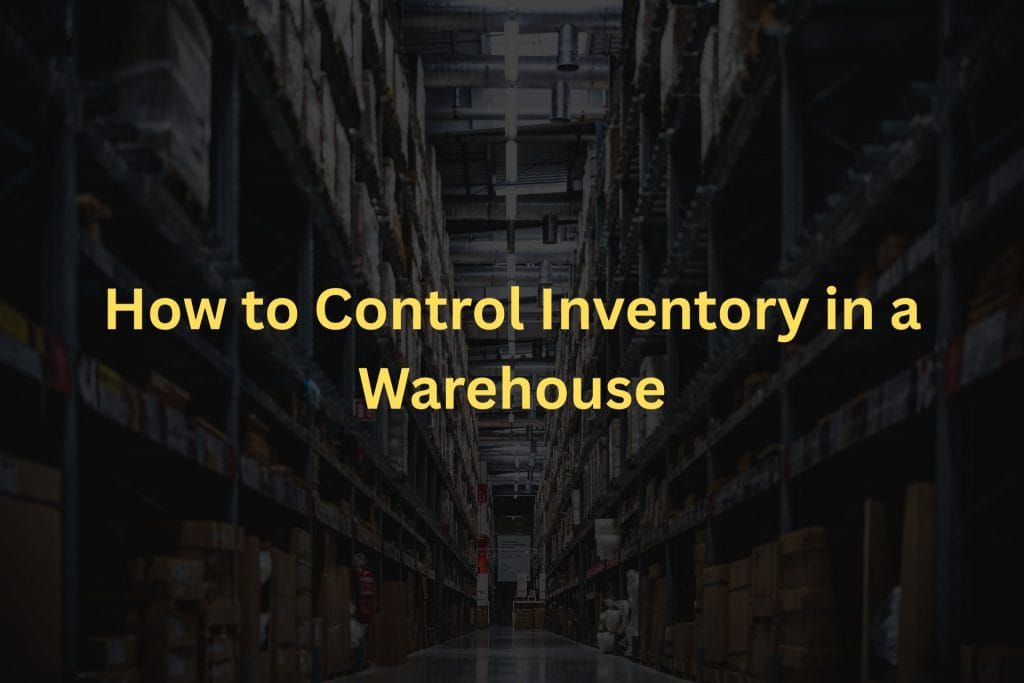Imagine stepping into a warehouse buzzing with activity—shelves stacked high, workers darting between aisles, and packages zooming out the door. It’s a whirlwind, right? But behind this hustle lies a hidden hero: inventory control. Without it, that busy warehouse could spiral into chaos, empty shelves, frustrated customers, or piles of unsold stock. If you’re a student or a curious newbie dipping your toes into supply chain management, this guide is your roadmap to understanding how to keep a warehouse running like a well-oiled machine.
What Is Inventory Control?
Let’s break it down. Inventory control is like being the conductor of a warehouse orchestra. Every product, from tiny bolts to massive crates, needs to be in the right place at the right time. It’s about tracking what’s in stock, knowing when to reorder, and making sure you’re not drowning in excess or scrambling for supplies. Sounds simple, but here’s the kicker: one misstep, and you could be stuck with a warehouse full of stuff nobody wants—or worse, nothing to sell.
So, how’s it different from inventory management? Think of inventory management as the big-picture game plan—deciding what to stock and how much. Inventory control, on the other hand, is the hands-on work: counting items, updating records, and keeping everything in check. It’s the difference between planning a party and making sure there’s enough food and drinks for everyone. The goal? Save money, keep customers happy, and make the most of your warehouse space. But don’t relax just yet, there’s more to this than meets the eye.
Why Inventory Control Matters
Why should you care about inventory control? Picture running a lemonade stand. Too many lemons, and they rot, wasting your money. Too few, and you’re turning away thirsty customers. Warehouses face the same drama, just on a grander scale. Good inventory control:
- Cuts costs by reducing storage expenses and avoiding stockouts.
- Boosts efficiency, ensuring products are ready when customers come knocking.
- Maximizes space, turning a cluttered warehouse into an organized hub.
But here’s where it gets dicey: mess up inventory control, and you’re dealing with overstocking (hello, wasted cash), understocking (goodbye, sales), or even sneaky theft.
The Building Blocks of Inventory Control
To master inventory control, you need to know its core pieces. These are like the ingredients in your favorite recipe—get them right, and you’re cooking with gas.
1. Tracking Systems: Your Warehouse’s Eyes and Ears
Keeping track of inventory is like playing detective. You need tools to follow every item’s journey from delivery to shipment. Small warehouses might get by with manual systems—think spreadsheets or handwritten logs—but as things grow, that’s a recipe for headaches. Enter automated systems. Barcode scanners zap items in seconds, while RFID (Radio Frequency Identification) tags let you track stock without even touching it. These tools update your records in real time, so you’re never left guessing. No more digging through piles of paper—hallelujah!
2. Stock Classification: Sorting the Stars from the Stragglers
Not every item in your warehouse is a rockstar. Some products fly off the shelves, while others sit there collecting dust. That’s where classification methods save the day:
- ABC Analysis: Splits your inventory into three groups. A items are high-value but low in quantity (think expensive electronics). B items are middle-of-the-road, and C items are low-value but high-volume (like screws or packaging). Focus on A items to save time and money. Read More…
- Just-in-Time (JIT): Orders stock only when you need it, keeping your warehouse lean and mean.
- Economic Order Quantity (EOQ): A nifty formula that calculates the perfect order size to minimize costs.
Sounds like a lot to juggle, right? Don’t worry—there’s a method to this madness, and we’ll keep it simple.
3. Cycle Counting: Keeping Your Numbers Honest
Ever double-checked your wallet to make sure you didn’t lose a dollar? Cycle counting is like that but for warehouses. Instead of shutting down for a full inventory count (a massive headache), you check small batches of stock regularly. This catches errors early—whether it’s a miscounted box or something walking out the door. Random cycle counts, done on the fly, keep everyone on their toes. Trust me, this small habit can save you big trouble.
4. Forecasting: Predicting the Future
Want to know what customers will buy next month? Forecasting is your secret weapon. By looking at past sales, seasonal trends, and market shifts, you can guess what’s coming. Get it right, and your shelves are stocked just right. Get it wrong, and you’re either stuck with unsold goods or apologizing to customers for empty shelves. The trick? Use historical data and stay sharp about trends—like holiday shopping spikes. Want to know how the pros nail this? Keep reading.
Strategies to Take Control Like a Pro
Now that you’ve got the basics, let’s talk strategy. These are the game-changers that turn a chaotic warehouse into a smooth operation.
1. Embrace Technology: Work Smarter, Not Harder
Modern warehouses are all about tech. A Warehouse Management System (WMS) is like the brain of your operation, tracking every item and syncing with suppliers. Cloud-based tools let you check stock levels from anywhere—yes, even your phone. And don’t sleep on barcode scanners or RFID tags—they’re like superpowers for accuracy. Imagine cutting errors in half just by scanning a tag. Pretty cool, right?
2. Organize Your Space: Make Every Inch Count
A messy warehouse is a nightmare. Optimize your layout by:
- Using shelves, bins, and pallets to keep things tidy.
- Designing picking routes that cut down on wasted steps. A well-organized warehouse is like a clean kitchen—you can grab what you need without tripping over chaos. Pro tip: Label everything clearly to avoid mix-ups.
3. Train Your Team: People Power Matters
Your staff is the heart of inventory control. Train them to follow Standard Operating Procedures (SOPs) to keep errors at bay. A missed scan or a wrong label can snowball into a disaster. Regular training sessions keep everyone sharp, and a little encouragement goes a long way. After all, a happy team is an efficient team.
4. Build Strong Supplier Relationships
Suppliers aren’t just names on a contract—they’re your partners in crime. Negotiate clear lead times to avoid delays, and keep the lines of communication open. A reliable supply chain means your warehouse stays stocked without hiccups. Nothing’s worse than waiting on a late shipment while customers tap their feet.
5. Handle Returns Like a Champ
Returns and defective goods are part of the deal. Set up a reverse logistics process to handle them smoothly—think of it as a return lane at a store. Quality checks before items hit the shelves can catch problems early. Want to see how a real company turned this into a win? Stay tuned for a juicy case study.
Tools That Make Inventory Control a Breeze
Technology is your best friend when it comes to inventory control. Here’s a rundown of tools that can transform your warehouse:
- Barcode Scanners and RFID Tags: Fast, accurate tracking that saves time.
- IoT Devices: Real-time monitoring of stock levels and even conditions like temperature.
- Inventory Software: Tools like Fishbowl, Zoho Inventory, or NetSuite handle everything from ordering to reporting.
When picking software, look for ones that play nice with your ERP (Enterprise Resource Planning) or CRM (Customer Relationship Management) systems. Integration means less work and fewer errors. And here’s a teaser: one of these tools could cut your inventory headaches in half.
Best Practices to Keep Your Warehouse Humming
Ready to level up? These best practices are like cheat codes for inventory control:
- Regular Audits: Schedule cycle counts and reconcile records to catch discrepancies.
- Set Reorder Points: Know when to restock by setting clear thresholds. Add a safety stock buffer for unexpected demand.
- Track KPIs: Keep an eye on inventory turnover rate (how fast stock moves), stock accuracy, and order fulfillment time. These numbers tell you what’s working and what’s not.
- Stay Curious: Adopt a lean inventory mindset, cutting waste wherever possible. Ever heard of Kaizen or Six Sigma? These continuous improvement methods can work wonders.
Follow these, and your warehouse will run smoother than a sunny afternoon breeze.
Common Mistakes to Dodge
Even the best-laid plans can go awry. Here are some traps to avoid:
- Ignoring Forecasts: Guessing demand instead of using data is like driving blindfolded.
- Sticking to Manual Processes: Spreadsheets are fine until they’re not. Automation saves time and sanity.
- Slacking on Supplier Communication: A quick call can prevent a delayed shipment.
- Skipping Training: Untrained staff can make costly mistakes.
- Outdated Records: If your inventory data’s off, everything else falls apart.
Avoid these, and you’re already ahead of the game. But what happens when a company gets it wrong—and then turns it around? Let’s find out.
Future of Inventory Control
The future of inventory control is exciting, and it’s coming fast. Here’s what’s on the horizon:
- AI and Machine Learning: These can predict demand with scary accuracy, analyzing patterns humans might miss.
- Drones and Robotics: Picture drones scanning shelves or robots picking orders—faster and with fewer errors.
- Blockchain: This tech ensures every item’s journey is tracked transparently, reducing fraud.
- Sustainability: Green practices, like minimizing excess stock, are becoming a must.
These trends aren’t just sci-fi—they’re already shaping warehouses today. Curious about how they’ll change the game? The possibilities are endless.
Related Posts
Defining ABC System of Inventory Control
What is Customer Relationship Management in Retail Industry?


